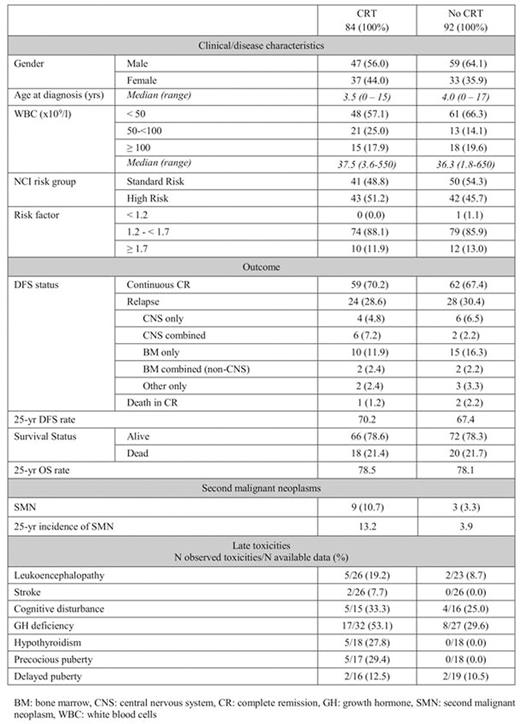Abstract
Background
Cranial radiotherapy (CRT) is associated with early and late side effects. Intrathecal (IT) and systemic chemotherapy could successfully replace CRT in most protocols for standard risk ALL. However, in medium and high risk ALL patients (pts) its omission is still debatable.
Aim
We investigated the long-term outcome, the occurrence of second malignant neoplasms (SMN) and the incidence of late toxicities in pts randomized for receiving or not CRT in the EORTC 58832 study.
Methods
From 1983 to 1989, ALL children under 18 years (yrs) were included in EORTC Children Leukemia Group BFM-oriented studies, either 58831, for standard risk pts (Riehm-Langerman Risk Factor (RF) < 1.2), or 58832, for medium risk (RF 1.2-1.69) and high risk pts (RF ≥1.7). Pts with central nervous system (CNS) involvement at diagnosis were ineligible.
The present report focusses on pts included in the 58832 trial (randomized for receiving or not prophylactic CRT).
Prophylactic CNS therapy consisted of 4 high-dose methotrexate (HD-MTX) injections (2500 mg/m2) during consolidation and 7 IT MTX injections scheduled during the treatment period.
Pts still in complete remission (CR) after the end of late intensification were randomized for receiving prophylactic CRT (standard arm) or not (experimental arm) before the start of continuation therapy. Dose of CRT was age dependent: 24 Gy (> 2 yrs), 20 Gy (1-2 yrs) and 16 Gy (< 1 yr).
Endpoints were: disease-free survival (DFS) (event: relapse, death in CR), incidence of SMN, event-free survival (EFS) (event: relapse, death in CR, SMN), incidence of late toxicities, and overall survival (OS) from randomization.
Results
788 pts were included in the 58831/58832 study. Among them, 189 were randomized in the 58832 study to receive CRT (n=93) or No CRT (n=96). A total of 6 pts did not meet eligibility criteria, 2 had an early relapse, 3 had an early protocol violation and 2 refused allocated treatment. Finally, 176 randomized pts were included in the analyses: 84 in the CRT group and 92 in the No CRT group.
The median follow-up was 20 yrs (range 4-32 yrs). Omission of CRT did not increase the 25-yr incidence of isolated CNS relapse, any CNS relapse or non-CNS relapse (4.8 vs 6.5; 11.9 vs 8.7 and 16.7 vs 21.8 in the CRT vs No CRT arms, respectively). No relapses occurred after 10 yrs. The 25-yr DFS rates were similar in both arms: 70.2% with CRT and 67.4% without CRT; No CRT vs CRT hazard ratio (HR)=1.08, 95% CI (0.63, 1.83).
CRT was associated with an increase of the 25-yr SMN incidence: 13.2% with CRT and 3.9% without CRT. In the CRT arm, 9 pts (10.7%) developed SMN: 2 acute myeloid leukemias (AML), 1 non-Hodgkin lymphoma, 1 thyroid carcinoma, 4 meningiomas and 1 malignant histiocytosis. One SMN (meningioma) occurred after a CNS combined relapse. Three pts developed second SMN (meningiomas): 1 after an AML and 2 after a first meningioma. In the No CRT arm, 3 pts (3.3%) had SMN: 1 pleomorphic xanthoastrocytoma, 1 melanoma and 1 adenocarcinoma of the ileum. One SMN occurred after a bone marrow (BM) relapse.
The 25-yr EFS rates were similar in both arms: 60.3% with CRT and 63.2% without CRT, HR=0.90, 95% CI (0.55, 1.46).
CRT was also associated with an increase of late CNS and endocrine toxicities. Five pts (19.2% of the pts with available data) developed leukoencephalopathy in the CRT arm, versus 2 pts (8.7%) in the No CRT arm. Noteworthy, 1 of those 2 pts received CRT for a BM relapse, while the other received total body irradiation for a CNS relapse. Stroke was observed in 2 pts (7.7%) who received CRT. In contrast, there was no clear increase of the incidence of cognitive disturbance after CRT: 33.3% in the CRT arm vs 25.0% in the No CRT arm. Regarding endocrine toxicities, GH deficiency, hypothyroidism and precocious puberty were more frequent in the CRT arm: 53.1% vs 29.6%, 27.8% vs 0% and 29.4% vs 0%, respectively.
Finally, the 25-yr OS rates were similar in both arms: 78.5% with CRT and 78.1% without CRT, HR=1.00, 95% CI (0.53, 1.88).
Conclusion
In medium and high risk pts without CNS involvement at diagnosis and treated with HD-MTX in the EORTC trial 58832 (1983-1989), omission of CRT did not increase the risk of CNS or non-CNS relapse. On long-term evaluation, CRT was associated with a higher incidence of SMN, late CNS and endocrine toxicities. These long-term results indicate that prophylactic CRT can be safely omitted in childhood medium and high risk ALL pts receiving IT and systemic chemotherapy (including HD-MTX) as CNS prophylaxis.
No relevant conflicts of interest to declare.
Author notes
Asterisk with author names denotes non-ASH members.


This feature is available to Subscribers Only
Sign In or Create an Account Close Modal